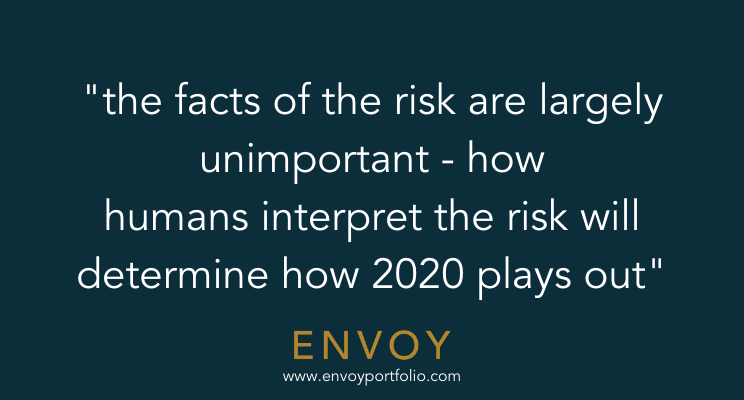
Navigating the Uncertainty of COVID-19 - What Business Leaders Can Do Now.
Based on recent urgent conversations with clients related to the continued spread of COVID-19 across all continents (barring Antarctica), we’ve put together a quick overview of the advice we’re providing clients who are being impacted by COVID-19 and the related fall-out. While we are not scientists and do not purport to know how this virus will continue to function, our expertise in human decision making, combined with our work across business, government and NGOs provide us with a unique vantage point into this growing global issue.
What We Know
COVID-19 is a type of novel coronavirus making its way around the world from the epicentre in Wuhan, China. Since the first reported cases in January 2020, it has impacted manufacturing in China and over the past month has been quietly stalling supply chains and imports. Many American companies sought additional resources after last year’s trade escalation with China and moved production of key resources to other countries. In many cases, production that remains in China is not easily replicated in the United States or other hubs. While the United States as a whole isn’t feeling impacted from COVID-19 yet (or paying attention), our clients are reporting disruptions to supply chains and travel.
What We Don’t Know
At this point, we do not know the extent the virus will spread in the United States or other countries. We cannot predict the overall impact COVID-19 will have on the US economy or whether it will tip the United States into technical recession earlier than economists have anticipated. Today, Goldman Sachs revised its earnings expectations for 2020, predicting “no growth” this year, and the International Monetary Fund is considering a similar revision for the global economy. We expect that the public will start paying closer attention if the stock markets continue to decline and once corporations release their Q1 earnings. Microsoft and Apple quietly revised Q1 earnings earlier this week, and we expect this trend will continue throughout the month.
That strategy you wrote for 2020. It's time to take a hard look at it. For some, to shred it and start again.
What Your Organization Can Do
1. Own the Uncertainty. There is a high likelihood that FY2020 will look very different than most organizations planned; even for those that took into consideration the likelihood of a recession and economic turbulence surrounding the presidential election. Organizations that acknowledge and accept the uncertainty and implement flexible responses and planning will be the most successful. Those that get frustrated by this period of uncertainty or are inflexible in their response will see the most fallout.
2. Focus on What You Can Control, Not What You Can’t. Organizations and leadership teams will need to focus on the aspects of their organizations and business that they can control. Ramping up offerings not reliant on China, following risk management protocols, engaging in regular communications with your work force. Determine what is within your control and create a pocket of certainty within the unknown. Leadership alignment and communications should be coordinated and reflective of a unified message and plan.
3. Look for the Contradictions / Opportunities. Organizations that will thrive over the next 12-18 months will be those that look for opportunities and use innovation to address contradictions within their current business lines and gaps in their offerings. This period will also provide organizations with unique opportunities to collaborate across business lines, pool resources and find mutually beneficial solutions. Organizations that build internal and external partnerships will be more likely to emerge from this period in a strong position. Those organizations that see increased competition and in-fighting increase the chance that they’ll lose additional market share on the other end as their competition capitalizes on the uncertainty.
4. Take Risks Based on Known Facts. While it will be tempting to try and forecast different scenarios for the upcoming year, major decisions should be made based on the facts known at the time. Predictions may not prove a useful tool given the unpredictability of the current situation. Even if COVID-19 slows over the next couple of weeks, damage has been inflicted on the global economy, travel industry and supply chains. Organizations that are looking to grow during this period will need to take risks in both offerings and alignment and try tactics novel to their industry and organizations. Even if an organization is only looking to remain stable, new tactics will be necessary. It will be imperative that organizations are transparent and real when addressing key stakeholders in decisions and should work to ensure buy-in from leadership, stakeholders and investors. Alignment is critical in crisis.
Over coming days, I'm meeting with leaders across healthcare, global transportation, and national security as we work out options for our clients. We'll likely publish more public media in coming days. In the meantime, if you're a leader grappling with this and you want to talk this through confidentially, drop me a note and we'll quickly set up a call.
In the meantime, remember: the facts of the risk are largely unimportant - how humans interpret the risk will determine how 2020 plays out.
Managing Partner of The Envoy Portfolio
27 February, 2020
Turning challenges into opportunities: an empathetic tech leader fighting the good fight against the Second Law of thermodynamics.
4yGood, looking forward to discussing.